

How Questions Promote Cognitive, Social, and Emotional Learning Across Subject Areas. In the last blog, we took a look at the perspective of perspective of Irving Sigel on the importance of asking different kinds of questions as a way of deepening students' social, emotional, and cognitive learning.
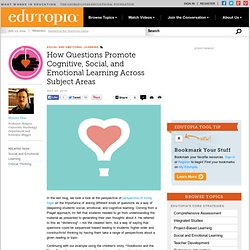
Coming from a Piaget approach, Irv felt that students needed to go from understanding the material as presented to generating their own thoughts about it. He referred to this as "distancing" -- not the clearest term, but a way of saying that questions could be sequenced toward leading to students' higher order and constructivist thinking by having them take a range of perspectives about a given reading or topic. Continuing with our example using the children's story, "Goldilocks and the Three Bears," you can see below the wide range of questions that can help children think of even a simple story in ways that promote many different kinds and levels of thinking: Low Level Distancing Medium Level Distancing High-Level Distancing.
5 Ways to Help Your Students Become Better Questioners. The humble question is an indispensable tool: the spade that helps us dig for truth, or the flashlight that illuminates surrounding darkness.
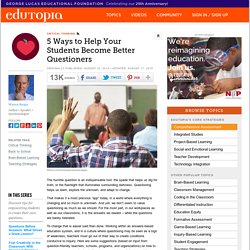
Questioning helps us learn, explore the unknown, and adapt to change. That makes it a most precious “app” today, in a world where everything is changing and so much is unknown. And yet, we don’t seem to value questioning as much as we should. For the most part, in our workplaces as well as our classrooms, it is the answers we reward -- while the questions are barely tolerated. Critical Thinking.
What Is Design Thinking? How might we engage students more deeply in reading?
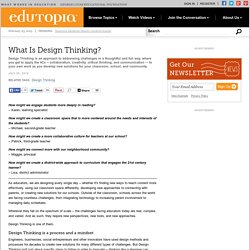
-- Karen, learning specialist How might we create a classroom space that is more centered around the needs and interests of the students? -- Michael, second-grade teacher How might we create a more collaborative culture for teachers at our school? -- Patrick, third-grade teacher How might we connect more with our neighborhood community? Understanding How the Brain Thinks. Judy Willis(@judywillis on Twitter) is an authority on brain research as it relates to learning.
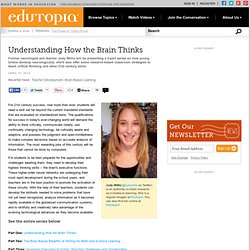
She is a regular blogger at Edutopia. You can also find her online at RADteach. For 21st century success, now more than ever, students will need a skill set far beyond the current mandated standards that are evaluated on standardized tests. The qualifications for success in today's ever-changing world will demand the ability to think critically, communicate clearly, use continually changing technology, be culturally aware and adaptive, and possess the judgment and open-mindedness to make complex decisions based on accurate analysis of information. Students Evolve from Consumers to Critics and Creators. Critical-thinking skills -- and fluency in multimedia production -- are integral to media literacy.
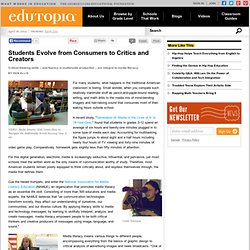
Running Time: 8 min. For many students, what happens in the traditional American classroom is boring. Small wonder, when you compare such relatively inanimate stuff as pencil-and-paper-bound reading, writing, and math drills to the media mix of mind-bending imagery and hair-raising sound that consumes most of their waking hours outside school. A recent study, "Generation M: Media in the Lives of 8- to 18-Year-Olds," found that students in grades 3-12 spend an average of six hours and twenty-one minutes plugged in to some type of media each day. Accounting for multitasking, the figure jumps to about eight and a half hours including nearly four hours of TV viewing and forty-nine minutes of video game play.
Credit: Edutopia Cue the herald trumpets, and enter the National Association for Media Literacy Education (NAMLE), an organization that promotes media literacy as an essential life skill. College Readiness: Reading Critically. We have a generation of students that are trained to automatically trust the textbook, or for that matter, trust anything that is written.
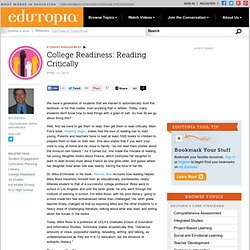
Today, many students don't know how to read things with a grain of salt. Understanding How the Brain Thinks. Understanding How the Brain Works For 21st century success, now more than ever, students will need a skill set far beyond the current mandated standards that are evaluated on standardized tests.
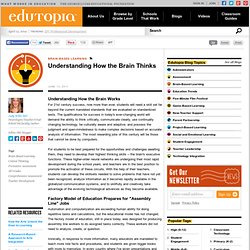
The qualifications for success in today's ever-changing world will demand the ability to think critically, communicate clearly, use continually changing technology, be culturally aware and adaptive, and possess the judgment and open-mindedness to make complex decisions based on accurate analysis of information. The most rewarding jobs of this century will be those that cannot be done by computers. For students to be best prepared for the opportunities and challenges awaiting them, they need to develop their highest thinking skills -- the brain's executive functions.
These higher-order neural networks are undergoing their most rapid development during the school years, and teachers are in the best position to promote the activation of these circuits. The High Costs of Maintaining the Factory Model. Training Teachers to Teach Critical Thinking. Kellan McNulty: Prior to coming to Kipp, I tried to do a fishbowl discussion and it failed.

And I had the kind of vague idea of how to do it, but I didn't have the specific tools. When I got to Kipp last year, we had a really good professional development on Socratic seminars that really showed me kind of the little tricks that made it work. My name is Kellan McNulty and I teach tenth grade AP world history and eleventh grade AP US history at Kipp King Collegiate. Katie Kirkpatrick: I think the hardest thing for teachers in adopting a critical thinking model is that it requires them to kinda step back and let the students do all the work.
And I think for a teacher who's used to being the agent of knowledge, it can be hard for them to take a back seat to the learning that's happening in the classroom. Kellan McNulty: Another thing that I started doing at Kipp is using like very specific structures to push students to critical thought.
Definition. Critical Thinking Pathways. Critical thinking is trendy these days.

With 6.3 million hits resulting from a Google search -- six times "Bloom's Taxonomy" -- its importance is undeniable. Worldwide, critical thinking (CT) is integrated into finger-painting lessons, units on Swiss immigrants, discussions of Cinderella, and the Common Core State Standards. Images. Critical Thinking. Research in Critical Thinking. The Center conducts advanced research and disseminates information on critical thinking.
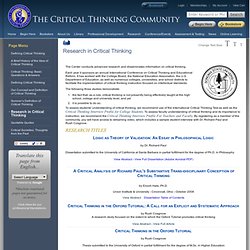
Each year it sponsors an annual International Conference on Critical Thinking and Educational Reform. It has worked with the College Board, the National Education Association, the U.S. Critical Thinking Index Page.